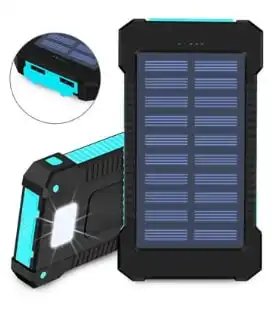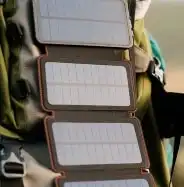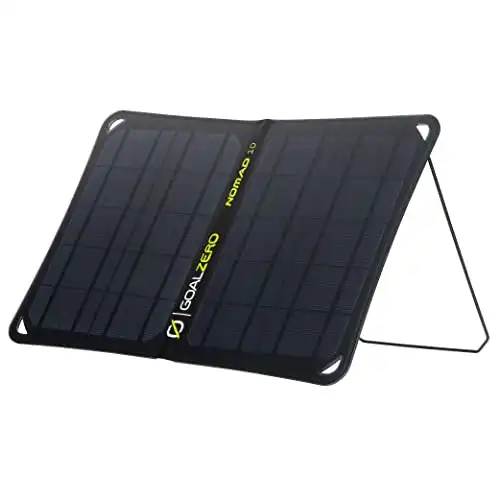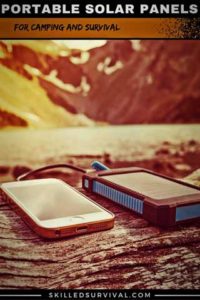
A Complete Guide To The Best Portable Solar Chargers
Because there’s been a recent boom in portable solar chargers.
And their increasing popularity has taken the world by storm.
These devices turn “free” solar energy into usable electrical power.
Energy to power all your electronic devices on the go.
The key here is portability.
They allow you to harness the sun’s power with a device that fits in your pocket!
TOPICS IN THIS GUIDE… ↓(click to jump)
- Best Portable Solar Chargers
- Portable Solar Charger Benefits
- Who Are They Made For?
- Best Portable Solar Setups
- Pros/Cons of Solar Chargers
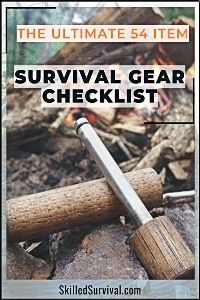
Want a free 54 item survival gear checklist?
Click here to instantly download this Complete Checklist PDF. No purchase necessary.Best Portable Solar Chargers For Camping & Survival
Here are a few of the best portable solar chargers we’ve used and own.
Skilled Survival highly recommends the Anytime Charge Solar Power Bank.
Why? Because it’s one of the most durable, compact, and cost-effective portable solar chargers on the market today. But don’t let its compact size fool you; it’s also got a massive 10,000 mAh battery capacity!
That's enough battery storage to charge any device multiple times over. Plus, with dual charging outputs, you can power multiple devices simultaneously!
Plug in your devices via the supplied USB cable (you can use any USB cable) and press the power button. Your device will begin to take power from the Anytime Charge right away.
Recharging the Anytime Solar Bank couldn’t be easier – leave it in the sun, and it will automatically fill the large battery bank ANYWHERE.
Plus, it’s splash resistant and comes with an emergency flashlight with a strobe function.
NOTE: When this article was published, you could snag some bonus Tactical Flashlights For FREE when you buy multiple Anytime Solar Chargers. Click below to see if this deal is still available!
↓ Portable Solar Power Bank!
The QuadraPro Dual USB Power Bank is a quality solar bank by Survival Frog.
It's got a huge 6,500mAH battery capacity with dual charging ability.
It's also rugged, splash-resistant, and ultra-compact - ideal features for any everyday carry or outdoor adventure.
For example, The QuadraPro comes ready to go out of the box!
The slim design means you can slip this power source into your pocket or backpack to have power while you're on the go!
↓ QuadraPro Power Bank Review
The Goal Zero Nomad 10 won't fit into your pocket but it's easy to stash in a vehicle.
But for the amount of juice it produces it's worth it. It weighs 1.2 lbs., and fits almost anywhere at 9.5x14.5x.75"(unfolded), 9.5x7.2x1.2"(folded)
This is a very high-efficiency panel. The 10W, 6-7V Panel has a built in USB port, great for small device charging.
Hook it on your backpack while hiking, or prop it up with the 180° adjustable kickstand.
It's design was developed by a US-based team combing over 50 years of experience with Solar And it comes with a 1 year manufacturer warranty.
As with most things, there are always tradeoffs, but you tend to get what you pay for.
↓ Goal Zero Guide 10 Plus Solar Recharge Kit Review
***The Goal Zero Guide 10 Plus Solar Kit giveaway mentioned in the video has ended.***
Benefits Of Owning A Portable Solar Charger
Portable Power
It’s power on the go.
You need one if you enjoy camping, hiking, hunting, or any outdoor adventure.
That way, you can keep all your small electronic devices charged and at the ready, just in case.
Whether it’s to call a loved one, stay on track with a GPS device, or charge some batteries for your flashlight.
Plus, the benefit of charging a phone without a charger in an emergency.
“Free” Power
These devices cost more than a few packs of batteries.
But it’s a one-time investment.
An investment that will easily pay itself off over time.
After the initial investment, you can charge your devices anywhere for ‘FREE.’
Backup Power
If you’re a regular visitor of Skilled Survival, you’ve thought about backup power.
If you haven’t, now is the time!
All your battery devices have a countdown timer when the power grid goes down.
Once the battery hits zero, it becomes an expensive paperweight until the power returns.
All your survival books on hunting and foraging…you know, the ones saved to your tablet? Gone.
The full-color step-by-step survival guides on your laptop?
The ones detailing how to build everything from a single-night shelter to a full log cabin?
Lost without power.
And while GPS satellites will continue to send data, it doesn’t matter if your GPS devices are dead.
Solar chargers are the perfect backup power solution for small electronic devices.
But why should you invest in a portable solar charger and not an extensive roof solar array/battery bank system?
First off, large rooftop solar systems are great. So are large solar power stations.
If you can afford to add solar panels to your home or to get completely off the grid, DO IT!
But they’re not portable.
So it’s a good idea to invest in a smaller-scale power generation tool for your everyday carry devices.
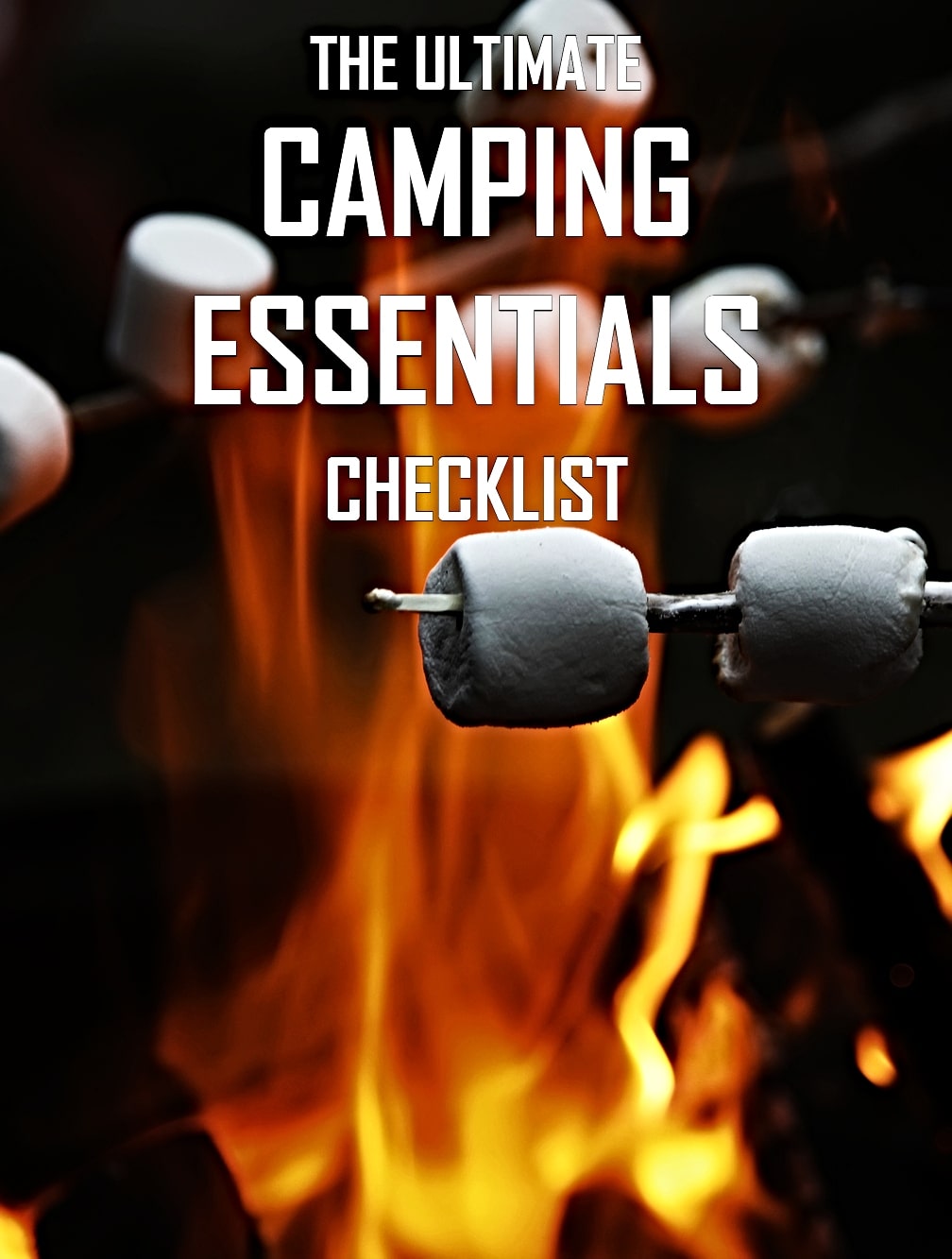
Want a free camping essentials checklist?
Click here to instantly download this Complete Checklist PDF. No purchase necessary.Who Should Own One?
Campers and Backpackers
Portable solar charges are great for camping on remote sites or in the comforts of a state park.
You’ve undoubtedly come across times when you’re getting low on power at either location.
Charging up the camera for a few more photos or boosting the GPS for you to follow your trail out is a great option.
And as they get smaller and more efficient, you’ll hardly notice it in your pack!
Solar chargers are quickly becoming essential gear for camping.
Heck most hand crank radios also solar powered radios so you have two grid free ways to keep tabs on the weather.
Hunters and Fishermen
Most hunters and fishermen carry cell phones and flashlights into the field.
They increasingly carry camera equipment, rangefinders, GPS devices, and night vision goggles.
These electronics add up to a lot of spare batteries.
A solar charger can take advantage of downtime during a sunny day to keep these devices topped off.
Backcountry Travelers and Emergency Situations
Every winter, we hear stories of a family outing turning deadly.
When someone blindly follows a seasonal road and finds themselves stuck in cold weather.
These people often used their vehicle’s batteries to keep warm.
However, eventually, even their vehicle batteries will die.
And their cell phones start dwindling along with their chances of rescue.
Using a portable solar charger to gain a few minutes of cell phone power can be enough to send an emergency text.
It can also help ping a cell tower, giving searchers a general search area to focus on.
Best Portable Solar Charger Setups
I own all three solar charger models (the ones reviewed above).
Two have an internal power pack, and one is paired with an external battery pack.
I use them differently for different reasons.
Shorter Trips – Internal
The internal battery systems are best for short-duration trips.
Ones where I won’t need more than one night’s worth of light or a partial GPS charge.
Enough power to find my way back to the truck, transverse backcountry mountain trails, or navigate an afternoon canoe trip.
These small solar chargers are lighter and take up less space in my pack than larger units making them excellent choices for “get home” bags, bug-out bags, or survival kits.
Longer Trips – External
For longer trips, I turn to the external battery model.
These allow me to use one battery pack while I charge a second.
This setup is larger and bulkier.
But along with the weight increase, you’ll also get more power generation.
Instead of trying to power your devices directly with this setup, you’ll use the portable solar panels to power an external battery bank.
Charging a battery pack in this way allows you to set up the charger in the most convenient location.
And this prevents you from being tethered to it at all times.
With the GoalZero Kit above, an external battery bank was provided.
However, this is not always the case…
Purchasing An External Battery Bank
If you purchase a portable solar panel that doesn’t come with an external battery, then you should buy one.
Many companies make USB battery packs. But, I prefer the most capacity for my dollar.
These are usually generic and off-brand battery packs.
Look for ones with a capacity of at least 10,000mAh and a price of around $25.
It should have one 2.1A or higher outlet for fast charging; a few extra outlets are always useful.
For example, The Anker PowerCore 10000 Portable Charger fits the bill.
The other bonus of charging battery packs (besides pure storage) is managing the variability of incoming solar power.
Yes, most battery packs will accept a wide variety of incoming voltages.
But “smart” devices are more restrictive on the incoming voltages.
This steady power requirement is to protect the internal circuits.
But this built-in device protection makes direct solar charging challenging.
For example:
Voltage variations trick my phone into disconnecting.
This issue happens whenever a cloud passes overhead OR sometimes for no apparent reason.
So it’s better to charge a battery pack first and then use the stored power to charge your devices.
This setup allows you to buffer out those pesky variations.
Thus, providing steady and consistent power to your devices.

Want a free 54 item survival gear checklist?
Click here to instantly download this Complete Checklist PDF. No purchase necessary.Pros & Cons
As with any device, there are pros and cons to owning one.
So let’s cover the advantages first and then discuss a few challenges.
PROS
- No Fuel
- No Trace Left Behind
- Silent
- Modular
- Lightweight
Let’s dive into each of these in more detail.
No fuel Needed
Solar is a clean energy source.
You don’t need liquid fuels or gases to run a generator.
You don’t need to burn wood to generate heat to create energy like a Biolite CampStove 2+.
Instead, portable solar chargers collect the heat from the sun to excite cells.
These exciting cells convert heat into energy.
You get to capture the sun’s energy rays hitting the earth day in and day out.
And while the sun’s energy is technically a fuel source, it’s abundant, available, and free.
No Trace Left Behind
Like the “no need for fuel,” you also capture the energy without leaving any trace behind.
It’s both a clean and zero-impact energy solution.
Silent
In survival, you never know when evasion is the goal.
One critical aspect of evasion is silence.
Capturing energy without a fire or a loud generator will keep your location hidden.
Modular
Many of these solar devices can be daisy-chained together to create a more powerful system.
Hooking up 2 or 3 or 10 in series will increase your power capabilities.
This means you’d be able to capture more solar power faster.
Allowing you to either power larger devices or fully charge your battery packs more quickly.
So buy one today and invest more in the future.
Doing this will increase your solar system’s output over time.
Light Weight
Many original “portable” solar panels were bulky and heavy.
By comparison, new portable solar panels are much lighter and more compact.
Many of the smaller models are the size of a deck of survival cards.
And feature integrated batteries for power storage – and still weigh under 8oz!
CONS
- Sun Required
- Need a Separate Battery Pack To Store Power
- Variable Output Issues
- “Perceived” Durability Issues
However, I believe the “cons” of a solar charger are either misunderstood or can easily be overcome.
Sun Required
The obvious argument against solar is that it only works when the sun shines.
That’s both true and false.
To be sure, at night, your solar charger isn’t going to be providing you with any electricity.
That’s why you need to pair it with a battery pack in the first place.
But what about cloudy or overcast days?
The latest photovoltaic cells used in solar panels are more efficient than ever.
They can convert a larger percentage of the incoming sunlight to electricity.
So while they may drop in output on a cloudy day, they can still charge your devices over more extended periods.
Need a Separate Battery Pack To Store Power
Solar cells don’t store power; they only convert solar to energy.
To store power, the device must either have an internal battery pack or you’ll need to invest in an external one.
Variable Output Issues
First off, the angle of the sun influences how much power is produced.
Pointing solar cells directly towards the sun captures the most amount of power.
But this requires constant fidgeting.
It’s a pain to continuously manage the orientation of the charger as the sun moves across the sky.
No, it’s not time-consuming and only needs to be done on the hour.
But it means you can’t leave it for long.
In desert climates, dust on the panels will reduce efficiency and keep you from charging even in full sun.
Also, the window tint in most cars is enough to reduce the collected power.
“Perceived” Durability Issues
Another misconception about solar chargers is that photovoltaic cells are extremely fragile.
Again, both true and false.
Large solar panels (those used on roof systems) are sandwiched between glass, laminate, or acrylic layers.
This allows them to take 120+mph winds, hail, and falling branches.
The chances of breaking one of these after installation are significantly minimized.
On the other hand, solar charger designs have significantly improved.
The latest ones are built for more rugged treatment than earlier versions.
They often feature plastic instead of glass.
They also now have rubber or plastic bodies surrounding the cells.
Final Thoughts
You should add at least one portable solar charger to your survival gear.
I’d encourage you to get one for each family member.
And to be sure to test how it works with your devices.
Chances are, you already have small electronics in your EDC and Bug Out Bag.
And you may even depend on them in an emergency.
Packable solar power is an EASY upgrade to your survival gear and your survival plans.
It’s a smart solar powered survival insurance policy.
One to guarantee access to communications, navigation, light, and information when you need it most.
Why Trust Skilled Survival...
Go here now to review a full breakdown of:
- Who We Are
- Our Credentials
- Our Mission
- & Product Recommendations...
Here are a few highlights of our teams credentials & certifications:
- Certified Member of a Mountain Search & Rescue Organization
- Plant Emergency & Safety Leader for a Major Food Manufacturer
- Member of the 10TH Mountain Division Hut Association
- Certifications: Avalanche 1, WFR, CPR
- Official Gear Tester for Numerous Outdoor Gear Companies
- Countless Multiday Backpacking trips into Remote Wilderness
- Bachelor's Degree In Mechanical Engineering
- Bachelor's Degree In Civil Engineering
- Bachelor's Degree In Biomedical Engineering
"It takes 20 years to build a reputation and five minutes to ruin it." - Warren Buffett
We're fully aware that TRUST is NOT something you GET but is EARNED.
And we'll continue to earn YOUR trust through our forthright and honest approach with each new Blog Post, Guide & Product we create...
Jason K.
P.s. Do You Live In A 'Danger Zone' County?

Find out now using my Danger Zone County List & Special Report it’s absolutely FREE.
In minutes you’ll know EXACTLY where you stand and if you should be worried or not..
So click here to get my FREE Danger Zone County List & Report…

Recommended Reading
Minimalist Camping: How To Avoid The Most Costly Mistakes
Minimalist camping is a great way to practice wilderness survival. Here's a short list of the limited items to take on your next camping trip
22 Creative Ways On How To Make Money With Land
The best 22 ways I know of on how to make money with land. Pick and choose the ones that will work best for you property and situation.
Best Cold Weather Tents To Survive Below Freezing Temps
Not all tents are created equal, and most are NOT good enough for winter camping. Here are the best cold weather tents for sale today.
21 Camping Essentials: WHAT You Should Take & WHY
Use this list of 21 camping essentials to ensure you never forget the most important gear on your next trip. 1. Tent 2. Water 3. Food 4. Knife...
Best Canvas Tents For Epic Camping, Hunting & Survival
The best canvas tents are durable, waterproof, mold resistant and 100% worth owning! In this guide, we review the best ones on the market to make your search easy.
5 Best Portable Toilets For Travel Emergencies
Poop emergencies happen to everyone, right? So why not pack some peace of mind knowing you've got a portable camping toilet at your disposal.
